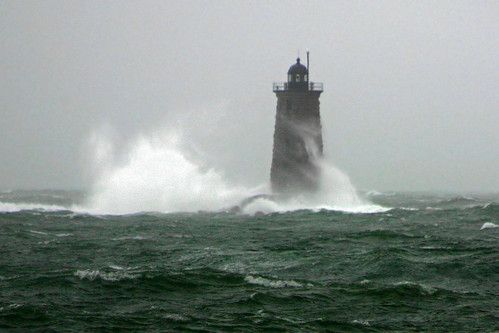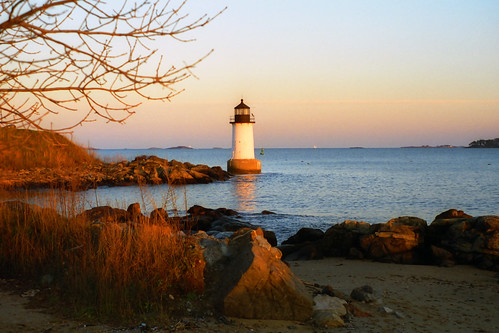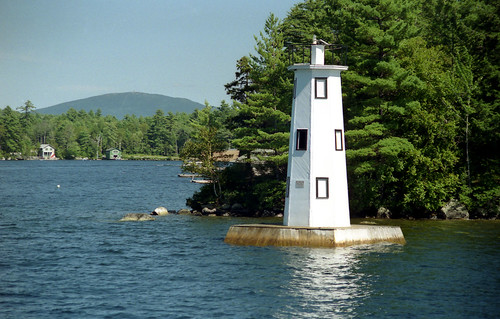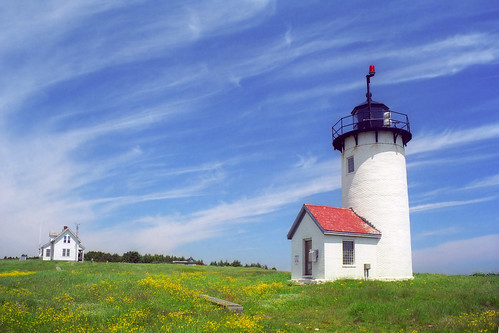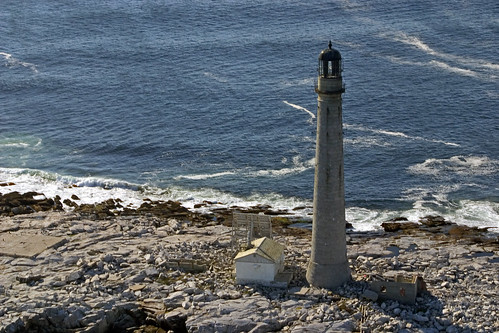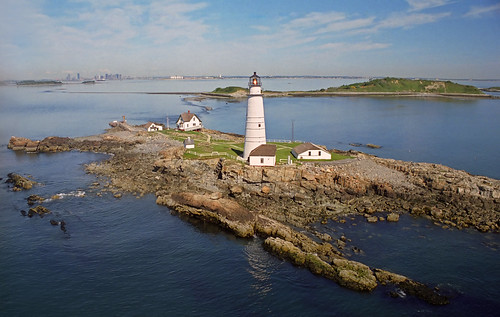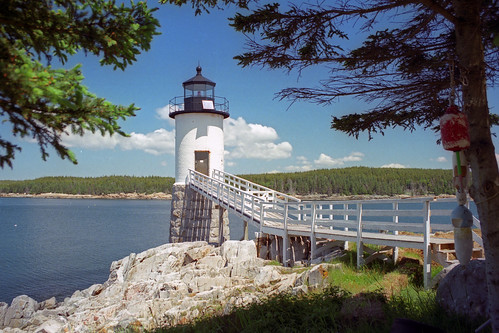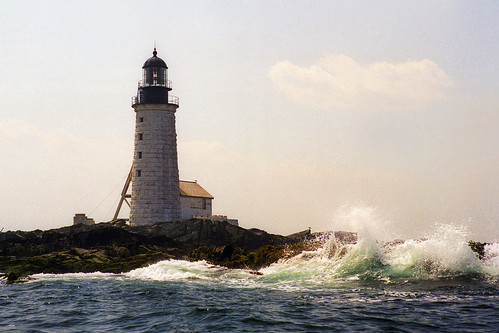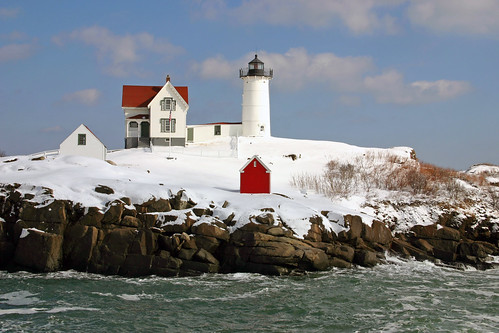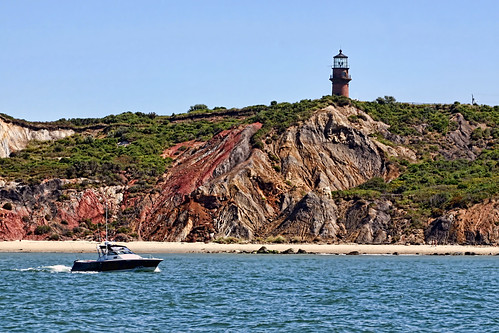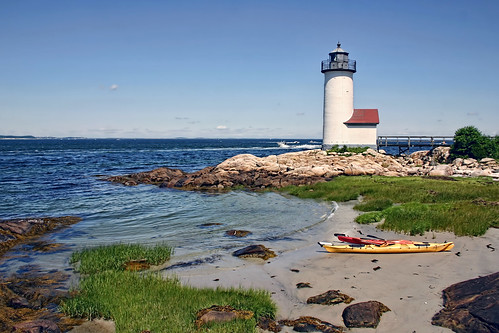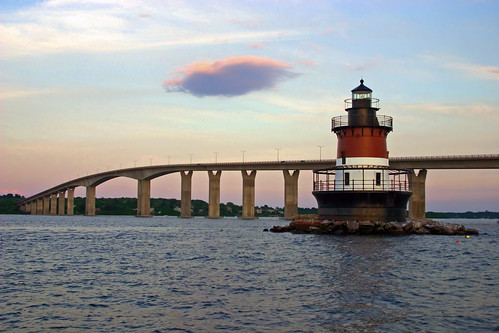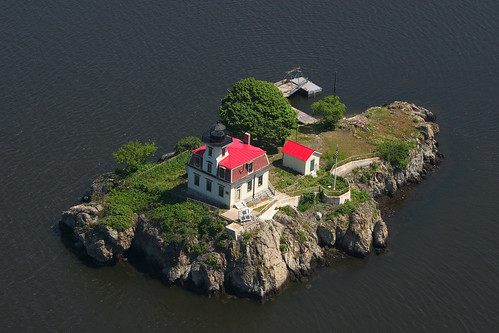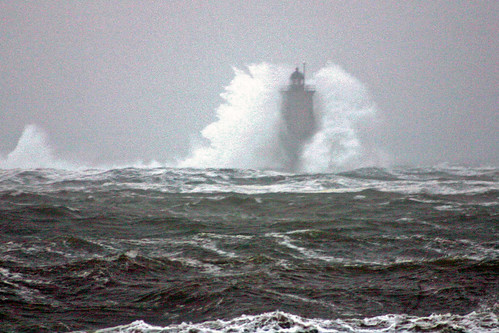Here's yet another shot from my June 2001 helicopter flight in Boston Harbor with the Coast Guard. The lighthouse tower and other buildings came out very nicely in this one, and I like the distant Boston skyline on the right. Click here for more on Boston Light.
Happy New Year, everyone!
Thursday, December 31, 2009
Photo of the Day: Aerial view of Boston Light
Wednesday, December 30, 2009
Photo of the Day: Aerial view of White Island Lighthouse, Isles of Shoals, New Hampshire
This photo, taken in September 2007, shows the damage done by a storm in April 2007; a covered walkway between the tower and house was destroyed, and the large solar panel near the lighthouse was washed away. Since then, a new solar power system has been installed along with an LED light, and some repairs to the structures have been completed. The walkway has not been rebuilt.
Click here for more on this lighthouse.
"The Lightkeepers"

A movie called "The Lightkeepers," starring Richard Dreyfuss, Blythe Danner, Bruce Dern, and Julie Harris, was recently shot on Cape Cod in locations including Race Point Lighthouse and the Atwood House in Chatham. The film will open nationally on March 12, 2010. If you live on or near Cape Cod, you can catch a special advance showing of the film at the Cape Cinema in Dennis. Click here for the schedule.
Tuesday, December 29, 2009
Photo of the Day: Whaleback Light (Kittery, Maine) in a storm in January 2006
Earlier, I posted a photo of a wave clearing the top of Whaleback Lighthouse (about 70 feet) in an April 2006 storm. The waves weren't as high in this January 2006 storm, but the visibility was a bit better.
I'm still waiting for the ideal conditions for a great Whaleback wave shot -- high seas and clear, sunny weather.
Monday, December 28, 2009
Photo of the Day: Fort Pickering Lighthouse, Massachusetts
This little cast-iron lighthouse on Winter Island in Salem can't be called impressive or spectacular, but it's a beautiful scene here at sunset. Just down the street from Winter Island is the old Salem Willows amusement park, where I spent many summer evenings as a kid.
For more on this lighthouse, click here.
Sunday, December 27, 2009
Photo of the Day: Herrick Cove Lighthouse, NH
This is one of three wooden lighthouses built on New Hampshire's Lake Sunapee in the 1890s in an effort to improve the safety of steamboat travel. The builders were the Woodsum Brothers, who ran the steamships that traversed the lake in its heyday as a resort.
This photo was taken a few years before a 2003 restoration, when the lighthouse was lifted by helicopter off its base. When the tower was lifted it was dunked briefly in the lake, as it turned out it weighed more than had been expected. It was was quickly lifted to safety in the yard of Court Cross, chair of the Lake Sunapee Protection Association's lighthouse committee. The crib base was overhauled and the outer wooden panels of the lighthouse were replaced by maintenance-free panels.
Click here for a 2003 article.
Saturday, December 26, 2009
Photo of the Day: Great Duck Island Lighthouse, Maine
I took this photo a few years ago when I visited Great Duck Island with some faculty and students from the College of the Atlantic in Bar Harbor. They own the light station and use it as a research station in the summer. Students monitor the bird population on the island, including the rare Leach's storm petrel.
Great Duck Island is about 9 miles offshore from Bar Harbor. We visited Mount Desert Rock Lighthouse, well over 20 miles offshore, on the same day. It was one of my most memorable lighthousing days ever.
Click here for more info on Great Duck Island.
Friday, December 25, 2009
Christmas at Lime Rock
 Have you ever thought what it must be to spend a Christmas day in a lighthouse? For fifty years my Christmases have been there. To you landsmen and women, a snowy Christmas generally means that the day is complete; but to the lighthouse keeper it is too often ushered in by a northeast gale.
Have you ever thought what it must be to spend a Christmas day in a lighthouse? For fifty years my Christmases have been there. To you landsmen and women, a snowy Christmas generally means that the day is complete; but to the lighthouse keeper it is too often ushered in by a northeast gale.As far as the eye can reach under the light, I see nothing but the fast-driving flakes, while the sea dashes white on the rocks and is a visitor at my windows, knocking noisily every few minutes.
The wind shrieks through this old house, rushes through the lantern with a noise like the shrill whistle of a steamboat foretelling danger, and even around the doors there is a chorus as if an army of fiends were attacking us.
But with all this against is in the elements, in my girlish days we had many jolly Christmases, for we were a large family of boys and girls, and liked, just as I do today, the pleasant giving and receiving of gifts, which marks the birthday of Christ.
Now, with only my brother Rudolph left, we make the day as jovial as can be, and my dinner with its turkey and ‘fixings’ of celery and cranberry sauce, its mince-pies and plum-pudding, I should like to share with you all.
-- Ida Lewis, keeper of Lime Rock Lighthouse, Newport, Rhode Island, 1890
Thursday, December 24, 2009
Photo of the Day: Aerial View of Boon Island Lighthouse, Maine
The writer Celia Thaxter called Boon Island "the forlornest place that can be imagined," and I wouldn't disagree. It's not pretty, but it has a fascinating history. The tower is now licensed to the American Lighthouse Foundation. Click here for more.
Wednesday, December 23, 2009
Tuesday, December 22, 2009
Photo of the Day: Rockland Breakwater Lighthouse, Maine
This was taken during a benefit cruise for the American Lighthouse Foundation. The haziness of the day helped create a beautiful sunset.
Click here for more on Rockland Breakwater Light.
Click here for prints.
Monday, December 21, 2009
Photo of the Day: Saddleback Ledge Lighthouse, Maine
This lighthouse at the southern end of East Penobscot Bay was a very difficult assignment for keepers. Believe it or not, the first keeper here, Watson Y. Hopkins, lived inside the tower with his wife and seven children. There were only three rooms!
In September 1843, Hopkins' wife gave birth to a baby girl. A week later, a boat came to the ledge to take the mother and daughter to the mainland. During the transfer to the boat, the baby was dropped briefly into the icy waves. She was quickly plucked out of the water before any serious harm was done.
Click here for more on this lighthouse.
Sunday, December 20, 2009
What a fool sees at 6am during a blizzard
This is just a beautiful image of one of New England's most photogenic little lighthouses, Brant Point Light on Nantucket, Massachusetts. It was taken at the height of the snowstorm that just buried much of the East Coast.
I didn't take this photo (although I wish I did), but I saw it on Flickr and it was too good not to share.
Photo of the Day: Cleveland Ledge Lighthouse, Buzzards Bay, Massachusetts
Saturday, December 19, 2009
Photo of the Day: Isle au Haut Lighthouse, Maine
I took this photo during my one and only visit to Isle au Haut -- I believe it was June 1996. I've photographed the lighthouse from the water a couple of times since then, but I haven't been back on the island.
The keeper's house at this lighthouse was run as a bed & breakfast inn from the late 1980s until recently by Jeff and Judi Burke. The inn has closed, but you can rent the keeper's house or an adjacent building by the week; see www.keepershouse.com
The author Linda Greenlaw spent summers here as a kid. You can read about it in her book, The Lobster Chronicles.
Thursday, December 17, 2009
Wreaths at Portsmouth Harbor & Portland Head Lights
Photo of the Day: Halfway Rock Lighthouse, Maine
This was taken during my first cruise near Halfway Rock, circa 1999. I've only been close to this lighthouse twice, both times on Les McNelly's boat Sea Escape II.
I'm always fascinated by remote offshore lighthouses like this. It's so hard to imagine living somewhere like this all year, through storms and all kinds of conditions. I interviewed a former Coast Guard keeper a few years ago and wrote this story.
This dramatic lighthouse is licensed to the American Lighthouse Foundation.
You can also read more on my website.
Wednesday, December 16, 2009
Photo of the Day: Watch Hill Lighthouse, Rhode Island
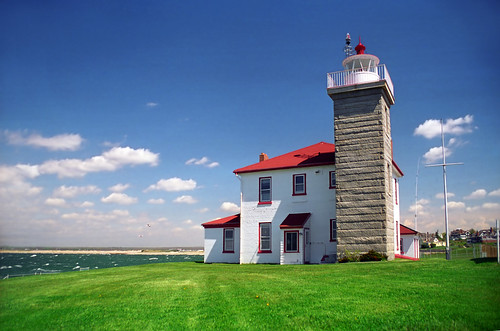
With a cold wind whistling outside today, I thought it would be a good idea to post a photo taken in warmer weather, featuring some nice green grass. This was taken during one of my first visits to Watch Hill, back in the 1990s. For more on this lighthouse, see lighthouse.cc/watchhill/
Tuesday, December 15, 2009
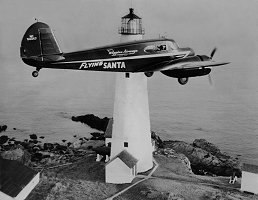 This holiday season, I hope you'll consider a donation to the Friends of Flying Santa. This nonprofit organization continues their annual gift of holiday cheer to the families of the United States Coast Guard here in New England.
This holiday season, I hope you'll consider a donation to the Friends of Flying Santa. This nonprofit organization continues their annual gift of holiday cheer to the families of the United States Coast Guard here in New England.This wonderful tradition dates back to 1929 -- you can read all about it on the Friends of Flying Santa website.
Also, check out this article on Eastbayri.com.

Lighthouse Art Raffle Winners Announced!

The drawing was held for Friends of Portsmouth Harbor Lighthouse's 2009 Art Raffle. The first prize, an original pointilist artwork by Randy Peterson, went to Barbara Kohl of North Hampton, NH. The complete list of winners is available here.
Congratulations to the winners, and thanks to all for the support!
Lighthouse of the Week: Pond Island Light, Maine

Ten-acre Pond Island, just south of the mouth of the Kennebec River, has no pond; the origin of its name is unknown. In March 1821, a quarter of a century after a lighthouse was erected in a commanding position on Seguin Island, near the mouth of the Kennebec, Congress appropriated $10,500 for three light stations, including one on Pond Island. The first small tower was accompanied by a stone dwelling for the keeper, with three rooms on the first floor and two small chambers in the attic. The station went into service on November 1, 1821.
The first lighthouse was poorly built and lasted only until 1835. In March of that year, the district lighthouse superintendent advertised for proposals for the building of a new stone tower, 13 feet tall to the base of the lantern, 14 feet in diameter at the base and 10 feet at the top. The tower was topped by an octagonal iron lantern, a little over 7 feet tall. The fixed white light was 55 feet above mean high water.
The station was examined by the civil engineer I. W. P. Lewis for his 1843 report to Congress. Lewis found the buildings in poor condition; the tower, although only a few years old, was leaky; its walls were cracked and stones were loose. David Spinney, who had been keeper for several years, added a statement to Lewis’s report. “The house wants pointing,” he wrote, “as it is very leaky and cold, and the chimneys are very bad and dangerous; they want a thorough repair. The cellar floor has rotted and fallen down. My cisterns are giving out, which will leave us destitute of water.”
Spinney was still keeper when, in November 1849, the vessel Hanover, returning to Bath from Cádiz, Spain, anchored near Pond Island in a storm. As the storm raged, the captain tried to tack around Pond Island and enter the western passage into the river. The ship ran into a bar off nearby Wood Island and soon sank with all 24 crewmen on board. Only a dog survived.
The present 20-foot brick tower was built and fitted with a fifth-order Fresnel lens in 1855, and a new wood-frame keeper’s dwelling was constructed and connected to the lighthouse tower by a short covered walkway. The focal plane of the fixed light was 52 feet above mean high water.
An article by Henry S. Bicknell in the New England Magazine in 1886 provides a glimpse of life on Pond Island. “We were told,” Bicknell wrote, "that the island provided pasturage sufficient for one cow, but, from a close observation, it was evident that she must be content with two meals a day, or to get an occasional donation from the meadows on the mainland. Twice a year the district inspector makes his rounds, and, during the week previous to his visit, the entire family devote all their energy in scouring and polishing, until everything about the place, from the doorknob to the lenses, fairly sparkles with brilliancy. On these occasions, the light-keeper is seen in his best mood, and is the perfection of politeness and urbanity, for then a hope of reappointment is betrayed in every movement."
Isaac W. Morrison, an avid fiddle player, became keeper in 1889. A young resident of nearby Popham Beach, Hiram Stevens, rowed out for lessons with the lighthouse keeper. Stevens later became a successful composer and had several pieces performed by John Philip Souza’s band. Morrison was keeper until 1903, when he suffered a stroke.
After four years at nearby Seguin Light, Napoleon Bonaparte Fickett became keeper in 1926. Fickett remained keeper until 1948, when he fell ill and retired. He and his family weathered the great storm of March 3, 1947, when surf broke over the top of the lighthouse. Down the coast in the same memorable gale, the Oakey L. Alexander ran aground near Cape Elizabeth Light.
In August 1960, the Coast Guard announced that the station would be automated. The fog signal was put under the remote control of the Coast Guard station at Popham Beach. The last keeper was Ronald D. Howard. All the buildings except the lighthouse tower were destroyed by the Coast Guard.
The island was transferred to the U.S. Fish and Wildlife Service in 1973, and it’s managed today as part of the Maine Coastal Islands National Wildlife Refuge. Pond Island supports nesting terns, eiders, and Leach’s storm petrels. The lighthouse can be viewed distantly from Popham Beach. Closer views are available from tour boats out of Boothbay Harbor and Bath.
See www.lighthouse.cc/pond/ for more information.
Monday, December 14, 2009
Sunday, December 13, 2009
Photo of the Day: Portsmouth Harbor Lighthouse, NH #2
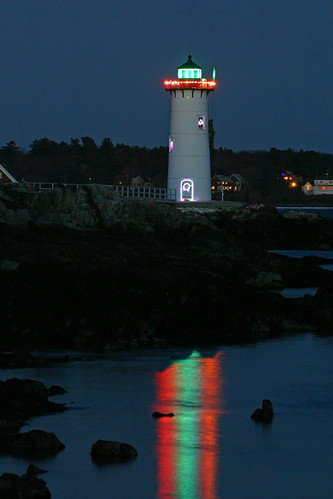

Last night, William and I visited the lighthouse to make some adjustments. I took the photo above a short time later as it grew dark.
The personnel of Coast Guard Station Portsmouth Harbor added a large wreath this year, welcoming incoming mariners to Portsmouth Harbor.
Saturday, December 12, 2009
Friday, December 11, 2009
Photo of the Day: Portsmouth Harbor Lighthouse, NH
Seems like this shot from last winter of Portsmouth Harbor Lighthouse in New Castle, NH, is an appropriate photo for this bitterly cold day.
See www.portsmouthharborlighthouse.org for more on this lighthouse.
Thursday, December 10, 2009
Photo of the Day: Gay Head Lighthouse and cliffs, Martha's Vineyard, Massachusetts
Taken from offshore during a benefit cruise for Friends of Flying Santa a few years ago. The Gay Head Cliffs are one of the most beautiful attractions on the New England coast.
Wednesday, December 9, 2009
Tuesday, December 8, 2009
Hospital Point Wreath

Scenic Hospital Point Light Station in Beverly, Massachusetts, serves as the residence for the commander of the First Coast Guard District. The Coast Guard Auxiliary has gotten involved with the lighthouse, with plans for occasional open houses.
Auxiliary members just put this wreath on the tower for the Christmas season -- the third year they've done it. "This has become an annual tradition, and we have a lot of fun doing it," says Phil Karwowski. Thanks to Phil for the photo and info!
Photo of the Day: Bear Island Lighthouse, Maine

A dramatic location that inspired many landscape painters in the 19th century -- for example, click here. For more on Bear Island, click here.
Monday, December 7, 2009
Photo of the Day: Pemaquid Point Lighthouse, Maine
This photo was taken last January on a icy, cold late afternoon. The fading sunlight was delicate and beautiful, but the walking near the lighthouse was treacherous.
I'm not a big fan of New England winters, but they do provide some neat photo opportunities.
Friday, December 4, 2009
Photo of the Day: Newport Harbor Lighthouse, RI
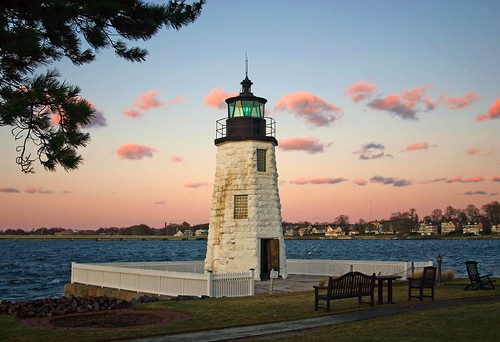
This photo was taken on a cold, blustery late afternoon, just before an American Lighthouse Foundation dinner in the Hyatt Regency Hotel on Goat Island, next to the lighthouse. The hexagonal stone construction of this lighthouse is unusual, and I like the style of the lantern. It's under the care of the American Lighthouse Foundation, and the picket fence was added a couple of years ago.
For more, go to lighthouse.cc/newportharbor/
Thursday, December 3, 2009
Photo of the Day: West Quoddy Head Lighthouse, Maine
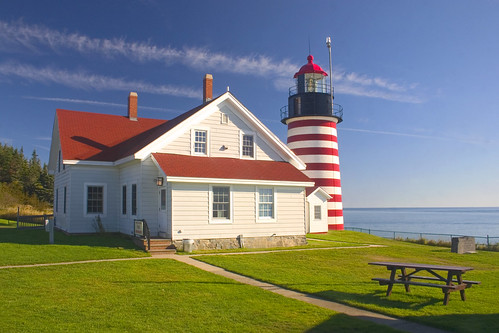
I'm featuring another photo of West Quoddy Head Light today partly because it gives me an excuse to tell you about a great article on this lighthouse on the Lighthouse-ornaments.com site -- click here!
Also, lots more on my site at lighthouse.cc/westquoddy/
Wednesday, December 2, 2009
GHOST CRUISE with the New England Ghost Project - 7/31/2010

Join Ron Kolek of the New England Ghost Project and Jeremy D'Entremont of New England Lighthouse Tours for a unique evening cruise, leaving Rye Harbor, New Hampshire, aboard the M/V Granite State at 7:00 p.m. on July 31, 2010. The cruise will return to the dock at 10:00 p.m.
The cruise will pass close to three lighthouses: Portsmouth Harbor, Whaleback, and White Island, as well as the Isles of Shoals and other points of interest. You'll learn about the ghostly Woman in White who warns of approaching storms at White Island, the longtime keeper who haunts Portsmouth Harbor Lighthouse, and much more. You'll hear first-hand accounts of paranormal investigations by New England Ghost Project.
Ron Kolek is the founder and lead investigator of the New England Ghost Project. With a degree in environmental science, he was the ultimate skeptic. A near death experience changed all that. No longer blinded by his skepticism, he now uses his scientific background to seek the truth about the paranormal. In addition to hosting Ghost Chronicles on Ghostvillage Radio and ITunes, he hosts a weekly internet radio show on Toginet.com, and writes monthly paranormal newspaper columns in the Stateline Review and Food and Spirits.
He is the co-author, with Maureen Wood, of the best-selling book The Ghost Chronicles: A Medium and a Paranormal Scientist Investigate 17 True Hauntings.
Click here for tickets!
Tuesday, December 1, 2009
Photo of the Day: Plum Beach Lighthouse, Rhode Island
Lighthouse of the Week: Block Island North Light, Rhode Island
 Block Island was long cursed as a stumbling block for coastal shipping traffic. The island is 14 miles from Point Judith, Rhode Island, and the same distance from Montauk Point, New York. Many shipping disasters were the result of vessels running up on the long sandbar that extends for a mile and a half from Sandy Point at the north end of the island. There was once a small peninsula called the Hummock at the northern extremity of the bar, a place frequented by islanders for picnics and berry gathering.
Block Island was long cursed as a stumbling block for coastal shipping traffic. The island is 14 miles from Point Judith, Rhode Island, and the same distance from Montauk Point, New York. Many shipping disasters were the result of vessels running up on the long sandbar that extends for a mile and a half from Sandy Point at the north end of the island. There was once a small peninsula called the Hummock at the northern extremity of the bar, a place frequented by islanders for picnics and berry gathering.In the decade preceding 1829, 22 ships were wrecked on Block Island. On March 2, 1829, Congress appropriated $5,500 for a lighthouse at Sandy Point to warn of the dangerous bar and to guide coastal traffic entering Long Island Sound from the east. Two lights, about 30 feet apart from each other on the roof of the keeper's dwelling, went into service on December 10, 1829. The first keeper was William A. Weeden, a native of Jamestown, Rhode Island.
Within a few years, the lighthouse was being severely threatened by the erosion of the sandy beach. Congress appropriated $5,000 on March 3, 1837, for the rebuilding of the lighthouse farther from the sea. The building was soon completed. Weeden remained keeper and moved with his family to the new site, which was in the dunes about a quarter-mile inland from the original site.
The 1837 lighthouse was certainly safe from encroachment from the sea, but the station was still plagued by the deep sands that shifted greatly in storms, and by seabirds that frequently smashed the lantern glass. The more secure location also rendered it less effective as a guide to navigation. The inland light sometimes confused approaching navigators, who assumed it was closer to the point.
The sum of $9,000 was appropriated in 1856 for the building of a lighthouse on the island’s southeast shore, but it was decided instead to use the funds for rebuilding of the North Light. The 1857 lighthouse was soon in danger of being lost to the forces of wind and sea, and $15,000 was appropriated for a new station on July 28, 1866. This time a sturdy granite combination lighthouse/dwelling was planned, similar in design to the ones built around the same time at several locations in Long Island Sound. The handsome and sturdy two-story granite dwelling has a cast-iron light tower at the front end of the peak of its roof.
Contractor John Beattie of Fall River, Massachusetts, obtained the huge granite blocks for the lighthouse from a quarry at Leete Island in Long Island Sound, near Guilford, Connecticut. According to Robert M. Downie in his book, Block Island—The Sea, the blocks were delivered to Block Island by a schooner, placed on skids, and hauled by oxen to Sandy Point.
The new light was illuminated for the first time on September 15, 1868, with a fourth-order Fresnel lens showing a fixed white light, 61 feet above sea level. The lighthouse is located about 400 yards south of its predecessor. Based on the fact that it is still safe and sound after 138 years, the Lighthouse Board must have selected the proper site this time.
Hiram D. Ball had taken over as keeper of the previous lighthouse in 1861, and he moved to the new one when it went into operation. Ball was a Block Island native who had first gone to sea at the age of 13 as a cook on a West Indies–bound schooner. At the age of 20, he became captain of the Newport schooner Eagle, and he went on to skipper a number of other vessels. In his History of Block Island (1877), S. T. Livermore described the lighthouse under Keeper Ball as a “favorite resort for visitors, both on account of the natural scenery, and the agreeableness of the respectable family of Mr. Ball, the keeper, whose ample means could furnish him a far more pleasant home, especially in winter.”
The next keeper after Hiram Ball was Elam Littlefield, another Block Island native who must have regarded Sandy Point as paradise after spending seven years at wave-swept Whale Rock Light at the entrance to Narragansett Bay. A few years after he arrived, Littlefield was given more responsibility when the light was changed from fixed to flashing. This meant that every four hours, the keeper (or a family member) had to wind a clockwork mechanism that rotated the lens on a bed of mercury.
Littlefield stayed for 32 years, longer than any keeper in the North Light’s history. About halfway through his tenure, his peaceful routine was spectacularly interrupted by one of New England’s most unforgettable shipwrecks.
Early in the evening of February 11, 1907, the Joy Line side-wheel steamer Larchmont left Providence bound for New York City in stormy conditions. The sole passenger list was on board, and there has been much debate over the number on the ship; it was probably somewhere between 120 and 200. A northwest wind was already blowing nearly 40 miles per hour as the steamer headed down the Providence River, and visibility was low. Shortly before 11:00, when the Larchmont was about three miles off Watch Hill Light, the schooner Harry Knowlton loomed out of the darkness and collided directly with the steamer. The wounds proved fatal, and the Larchmont sank in less than 15 minutes.
Capt. George McVey and seven other crewmen escaped in a lifeboat and apparently tried to pick up survivors, but the harsh conditions prevented it. Some of the passengers managed to launch five additional lifeboats and a raft into the frigid waves. The icy winds propelled them directly toward the gleam of the Block Island North Lighthouse.
Keeper Littlefield was awakened early in the morning on February 12 by the frantic barking of his dog, Leo. The keeper was then startled by someone knocking on a window. When he opened the door, a teenaged boy fell near his feet, nearly dead. “More coming, more coming,” was all he could manage to say. The boy, Fred Heirgsell, later said that he had nearly given up hope, but was encouraged when he heard the barking dog.
Littlefield woke his wife and children and phoned the nearby lifesaving station. Captain McVey reached Block Island alive along with seven others in the crew. Only three passengers arrived at the island alive in the other lifeboats, and the heroic crew of the fishing schooner Elsie rescued another eight survivors after they drifted for 12 hours atop the deckhouse.
The keeper’s wife and children played a major role in caring for the survivors. The lighthouse became a makeshift hospital, with strips torn from bedspreads used as bandages. In 1974, Block Island historian Robert M. Downie interviewed the keeper’s daughter, Gladys, who was 17 at the time of the Larchmont disaster. Gladys ran errands between the lighthouse and lifesaving station during the ordeal. She told Downie about one man who was brought into the kitchen, more dead than alive. One of the lifesaving crew and Gladys’s sister, Austis, tried to revive the man, but he died. Gladys vividly recalled the arrival of Captain McVey, who simply said, “Two hundred lives lost.”
Keeper Littlefield had the solemn duty of taking his horse and cart along the beach, picking up the bodies that had come ashore and taking them to the lifesaving station. The exact number will never be known, but over 100 had perished, with more than 40 bodies washing up at Sandy Point. The remains of the Larchmont now lie in about 130 feet of water, three miles southeast of Watch Hill.
In the spring of 1956, the Coast Guard was preparing to automate and destaff the light station. The last Coast Guard keeper was 23-year-old Seaman Donald M. Lawson, from the Allston section of Boston. Lawson lived at the lighthouse with his wife, Margaret, their one-year-old son, Ricky, and a large tomcat (“a good mouser”) inherited from previous keepers. Lawson painted the interior walls of the lighthouse bright yellow. “There wasn’t much else to do,” he explained.
Coast Guard personnel occasionally checked on the equipment after automation, but little maintenance was done on the building. It didn’t fare well in the harsh environment, and occasional intrusion by vandals didn’t help. The exterior woodwork began to rot and rain got inside the lighthouse. Near the end of 1972, the Coast Guard erected a steel skeletal tower north of the lighthouse with an automatic flashing light, and the old building was boarded up and abandoned in January 1973. By this time, the roof was practically caving in.
Officials of the town of New Shoreham let the Coast Guard know of their interest in the lighthouse. Soon a new committee, the North Light Commission, was formed, with members appointed by the town council. The lighthouse would eventually belong to the town, but it took a circuitous route. It was turned over along with the surrounding 28 acres to the U.S. Fish and Wildlife Service in 1973 and was designated the Block Island National Wildlife Refuge. Since then, the refuge has grown to incorporate 127 acres.
About $80,000 in grants and donations was used to complete phase one of the lighthouse’s restoration, the renovation of the building’s exterior, by 1980. The roof was replaced, along with all flashings, moldings, windows, and the railing around the lantern gallery. Bulletproof (and vandal-proof) Lexan panes were installed in the lantern, and much of the rotting wood trim was replaced. In November 1983, the lighthouse was transferred from the U.S. Fish and Wildlife Service to the town along with two acres of land, in exchange for a perpetual conservation easement on 20 acres of migratory bird habitat. Over the next few years, more work was completed on the building’s interior.
Work on the interior continued, and by the summer of 1993 the first floor of the lighthouse was opened to the public as a museum. From Memorial Day to Labor Day in 1994, more than 14,000 slogged through the soft sand to visit the lighthouse.
Among the leaders in the long haul to restore the building is Rob Gilpin, a mason by trade. Gilpin had worked all over Block Island, but said that working at Sandy Point gave him a new appreciation for the loneliness and hardship endured by the light’s keepers. Gilpin is now co-chair of the North Light Commission and the North Light Association. The North Light Association was founded a separate nonprofit membership organization to raise funds for the restoration of the lighthouse.
An inspection in 2001 showed that the lighthouse still needed major work. The iron tower had badly deteriorated, especially where it met the rest of the building. The cost of the restoration of the tower and roof is about $700,000. The town was awarded $400,000 in June 2002 from the federal Transportation Enhancement Program, and a $100,000 State Preservation Grant was announced on December 6, 2006. Another $100,000 was awarded by the town, and $95,000 in donations to the North Light Association were applied to the project.
In June 2008, the lantern was removed from the building and transported to Georgetown Ironworks in Massachusetts for a complete overhaul. After the work on the building and the lantern was completed, the lantern was returned to its home in the summer of 2009. The ultimate goal is to have overnight accommodations in the lighthouse available to the public.
Click here for more information.
Click here for photo prints.
Monday, November 30, 2009
Flying Santa visits Canada, 1949

My friend Chris Mills in Nova Scotia has alerted me to a great audio clip available online on the CBC Archives site. The clip is from Nov. 21, 1949, and concerns the visit of the Flying Santa, Edward Rowe Snow, to Atlantic Canada lighthouses that year. Click here to go to the page.
This year's Flying Santa flights to lighthouses and Coast Guard stations will take place over the next couple of weeks -- you can read all about it on the Friends of Flying Santa website.
Photo of the Day: Pomham Rocks Lighthouse, Rhode Island
This little island in the Providence River has a storybook look to me. It looks like something you'd stick into a model train setup.
The Friends of Pomham Rocks Lighthouse, a chapter of the American Lighthouse Foundation, has done a tremendous job with this lighthouse in recent years; an exterior restoration was completed in 2006, leading to the relighting of the lighthouse after many years in darkness. You can read more about Pomham Rocks here and here.
Portland Head Light and the Lighthouses of Maine's Casco Bay Documentary Trailer
Anyone interested in Maine lighthouses should own this DVD. The visuals are spectacular, and there's lots of interesting human history packed into it. It's been a pleasure working with Vince and his wife, Lina, and this and their upcoming documentary on the lighthouses of Southern Maine. You can read more about them on their website.
Click here for more on the December 6 Arts & Crafts Fair.
Sunday, November 29, 2009
Photo of the Day: Saybrook Breakwater Lighthouse, Connecticut
I took this photo on a blustery day in October 2004. I was part of a group that was supposed to go inside the lighthouse that day, but it was obviously impossible with the seas breaking right over the breakwater. I hope I get another chance one of these years.
Saturday, November 28, 2009
Lighting of the Nubble Today!
 The annual Christmas lighting of the Cape Neddick "Nubble" Lighthouse in York, Maine, takes place today.
The annual Christmas lighting of the Cape Neddick "Nubble" Lighthouse in York, Maine, takes place today.Festivities get underway at 5:00 p.m. at Sohier Park with entertainment including the York High School Chamber Singers. The event includes traditional Christmas melodies along with kiddie carols - something for the whole family. The United Divers of New Hampshire will raise the lighted tree from the ocean, and there will be a visit from Santa, who arrives by way of a York Beach Fire Dept. ladder truck.
At the proper time, everyone will count down the seconds before the lighthouse is lit in its holiday glory. holiday lights. There's plenty of hot chocolate and cookies for all.
A COMPLIMENTARY SHUTTLE SERVICE IS AVAILABLE FROM ELLIS PARK AT SHORT SANDS BEACH FROM 3:30 P.M. - 7:00 P.M
Lighthouse of the Week: Fort Point Light, Maine

In the 1800s, the peaceful town of Stockton Springs was a lumber port and a shipping point for Maine’s potato industry. Cape Jellison, a triangular wedge of land about two miles long, occupies the southern portion of the town. At the eastern corner of Cape Jellison is Fort Point, which juts far out far into the west side of the entrance to the Penobscot River. The point gets its name from adjacent Fort Pownall, built by order of Massachusetts Royal Governor Thomas Pownall (Maine at that time was part of Massachusetts) in 1759 to guard against the French.
As Bucksport and Bangor—located on the Penobscot River to the north—flourished as important lumber ports, Congress recognized the need for a lighthouse at Fort Point. The first lighthouse, 24 feet tall to the lantern deck, went into service in 1836. It was Maine’s first light station on a river. The initial keeper was William Clewley, who had sold his land to the government for the station.
In 1855, while the master mariner John Odom was keeper, the Lighthouse Board called the station “entirely worn out” and recommended that it be rebuilt. After a $5,000 appropriation in August 1856, a new tower and dwelling were built. The work was completed in 1857 and a fourth-order lens replaced the old multiple lamps and reflectors. The 31-foot-tall square brick tower is attached to the two-story, wood-frame keeper’s dwelling. The lighthouse’s lantern was replaced in 1868.
Hiram Grant, who was wounded in the Civil War, was keeper from 1866 to 1882. Because of its beautiful and accessible location, Fort Point Light was a sought-after station for keepers. A total of only four men kept the light from 1882 to 1952: Adelbert Webster (1882–1902), John Thurston (1902–19), Edward Farren (1919–29), and Arthur B. Mitchell (1929–1952).
Arthur B. Mitchell, who was born in Cambridge, Massachusetts, in 1879, went to sea as a young man and eventually became the captain of the two-masted schooner George W. Collins. When he married his wife, Elizabeth, in 1908, the two sailed the schooner to Duxbury, Massachusetts, for their honeymoon.
Mitchell’s experience before he arrived at Fort Point included several years at the isolated Matinicus Rock Light Station. His era at Fort Point encompassed the installation of an incandescent oil vapor lamp in 1935; Mitchell said it made more light but also more work.
In June 1950, the light was converted to electricity, making the keeper’s work much easier. With the change to electricity, the light was intensified to 4,500 candlepower.
Mitchell once made the newspapers when a weather prediction turned out to be nearly on target. At the start of the winter of 1937–38, Mitchell predicted the unusually high total of 38 storms. A brief news item in May 1938 confirmed that there had been 35 such storms, and Mitchell was “waiting anxiously for three more snowstorms.”
Mitchell’s grandson, Arthur Curtis, spent a good deal of time at the light station as a boy. One morning, he raised the American flag in an effort to help out. Later in the day, his grandfather got a call from Bangor asking what was wrong at the station. Young Arthur had accidentally raised the flag upside down, a universal signal of distress. A person on a passing ship had reported the signal.
Fort Point was long a regular destination of New England’s “Flying Santa,” who dropped Christmas presents from a plane for lighthouse keepers and their families. In a 1932 letter printed in the Rockland Courier-Gazette, Mitchell expressed his gratitude to Bill Wincapaw, who started the flights in 1929. “Our dog was the first to hear the sound of the motor,” Mitchell wrote, “and then we all rushed out in time to see the plane circle over the reservation and go sailing down over the Penobscot again. We all join in wishing you and yours the happiest New Year ever.”
Shortly before Mitchell retired, his wife was quoted in the Maine Sunday Telegram: “We never really felt cut off here because we have the telephone, radio and books. We have mail service now and during the winter the town keepers the road plowed out so we are never snowed in for very long.”
The light was automated in 1988, and Larry Baum was the last Coast Guard keeper. After automation, the Coast Guard leased the station to the State of Maine, and the keeper’s house became housing for a park ranger and his family. The ranger turned out to be Terry Cole, who had been the Coast Guard keeper at the station years earlier. He was thrilled to return to his old home.
Keeping an eye on the lighthouse and fort, giving impromptu tours, and maintaining all of the buildings keeps Cole busy in summers. In the off-season, he also works as the archivist in charge of special collections at the Belfast Public Library. He enjoys historic research and has documented much of the light station’s history.
Under the Maine Lights Program, the station became the property of the State of Maine Bureau of Parks and Land in 1998. To support the preservation of this light station, contact Friends of Fort Point State Park, c/o Maine Bureau of Parks and Lands, 106 Hogan Road, Bangor, ME 04401.
The Coast Guard maintains the active light and automatic fog signal; the fourth-order Fresnel lens remains in service. There are signs on U.S. Route 1 in Stockton Springs pointing the way to 120-acre Fort Point State Park and the lighthouse, and a 200-foot pier is available for visitors arriving by boat.
For more, see lighthouse.cc/fortpoint/
For photo prints, see www.shutterfly.com/pro/dentremont/mainelighthouses/FortPoint
Photo of the Day: Whaleback in a Storm
As I sit hear listening to the wind howling outside today, it seems like a good idea to make this the photo of the day.
This photo of Whaleback Lighthouse in Kittery, Maine, was taken at high tide during a storm on April 16, 2007. The lighthouse is over 60 feet tall. This photo was taken from Great Island Common in New Castle, New Hampshire. The image is grainy because the visibility was very bad during the storm; it was raining heavily.
Friday, November 27, 2009
Photo of the Day: Rockland Breakwater Lighthouse, Maine
Took this last year during a sunset cruise from Rockland. Happy Day After Thanksgiving!
Wednesday, November 25, 2009
Happy Thanksgiving!
Tuesday, November 24, 2009

I'll be signing some of my lighthouse books this Friday, November 27, in Rockland, Maine, at the gift shop/interpretive center of the American Lighthouse Foundation. Award-winning graphic artist Alan Claude will also be there, signing prints from his Maine Collection series.
Click here for more info -- I hope to see you there!
Photo of the Day: Ida Lewis Yacht Club in Newport, Rhode Island
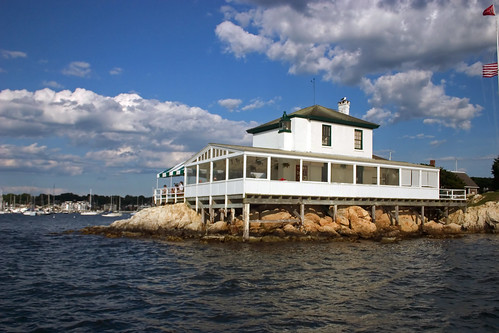
This building began its life as the Lime Rock Lighthouse, built in 1857. Ida Lewis, daughter of the light's first keeper, lived here for 54 years and became the most famous lighthouse keeper in U.S. history. She was credited with the rescues of 18 people from drowning in Newport Harbor, but the true number was much higher. Celebrated in story and song, she was one of the most famous women of the 19th century. You can read much more on my website at lighthouse.cc/limerock/history.html
Producer Marian Gagnon is currently making a documentary on Ida Lewis; see www.goodnightireneproductions.com
Monday, November 23, 2009
Neil Odams receives 2009 Len Hadley Volunteerism Award
 Neil Odams, owner of Captain and Patty's Cruises, honored with a 2009 Len Hadley Volunteerism Award at the American Lighthouse Foundation's annual Lighthouse Gala & Volunteer Awards Dinner at the Nonantum Resort in Kennebunkport, Maine, on November 7. The award was given in recognition of his donation of fundraising cruises for Friends of Portsmouth Harbor Lighthouse every Tuesday evening.
Neil Odams, owner of Captain and Patty's Cruises, honored with a 2009 Len Hadley Volunteerism Award at the American Lighthouse Foundation's annual Lighthouse Gala & Volunteer Awards Dinner at the Nonantum Resort in Kennebunkport, Maine, on November 7. The award was given in recognition of his donation of fundraising cruises for Friends of Portsmouth Harbor Lighthouse every Tuesday evening. You can click here to read the whole story. Congratulations to Neil for an award that was well deserved!
Photo: Captain Neil Odams aboard the Sir William Pepperrell
Photo of the Day: Prudence Island Lighthouse, Rhode Island
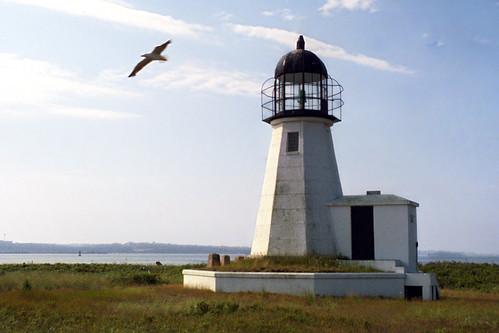
I took this photo a decade or so ago, during my only visit to Prudence Island. I barely made the ferry from Bristol, RI, arriving about a minute before it left. The other memory that stands out is that I met a couple of people who lived in homes neighboring the lighthouse, and they couldn't have been nicer.
For me, this lighthouse stands as a memorial to the five people who died when the keeper's house was swept away in the hurricane of 1938. See lighthouse.cc/prudence/history.html and this article.


